1 Introduction
More than 12 TWh/a are consumed by around 53,000 PDC in Germany (Fichter and Hintemann 2014). This energy consumption is expected to grow to 14 TWh/a by 2020 (Hintemann 2016). Information and Communication Technology (ICT) products have a short lifetime between 3 to 5 years (Garnier 2012), indicating that the energy consumption outside of the service phase is also of relevance. The number of servers grew by 28% for the period 2010–2014, with the trend to build bigger data centers (Hintemann and Clausen 2014). This is accompanied by the increasing material intensity in ICT, so the material demand for these applications rises in parallel to the energy consumption. The TEMPRO Project (Total Energy Management for Professional Data Centers), financed by the Federal Ministry for Economic Affairs and Energy (BMWi) in the framework of the 6th Energy Research Program of the Federal Government, has as one of its objectives the creation of an assessment basis for the holistic analysis of energy and resource efficiency of PDC.
The objective of this analysis is to assess the amount of energy consumed by a unit of a PDC equipment, a server, in its various stages. Emphasis is placed on analyzing the dependencies of the results on embodied energy in combination with the data on the energy consumption for the operation phase of a ICT device with the results on the evaluation of the quantities of materials required for the production and operation phases. The concept of embodied energy attached to the steps of raw parts production, manufacturing, transporting, decommissioning and recycling are often excluded when analyzing energy consumption or improvements on energy efficiency, which focuses mostly on the use phase, and overlooks the importance of the critical material content of ICT applications. Studies into the energy use of ICT devices during its life cycle prove that as the equipment becomes more operationally efficient, the embodied stage will play a larger role in the full life cycle (Whitehead et al. 2015).
The goal of this analysis is to assess the energy and material consumption of a server during its lifetime. For this purpose, the concepts of CMD and CED are applied (Giegrich et al. 2012). Existing gaps in the data availability are considered and attempted to close in some areas, through technology comparison and Pedigree Analysis.
2 Methodology
2.1 PDC Components
The structure of a PDC differs from each other. Common classifications of PDC characterize them by size (surface area, m2), by ICT installed capacity (kW), or by total installed capacity (including all facilities, kW) (Fichter et al. 2010). This information excludes data on the number and type of devices, or on the various aspects of the PDC configuration, such as redundancy, cooling technologies and type, safety, or energy sources. Additional information relevant to the estimation of the CED and CMD, such as individual energy consumption, operating lifetime, or energy conversion efficiency of the power supply infrastructure, are normally unavailable. To analyze the energy indicators of a PDC, an individual analysis of the various components is to be developed to obtain single indicators that can be aggregated and extrapolated for an estimation of the total indicators.
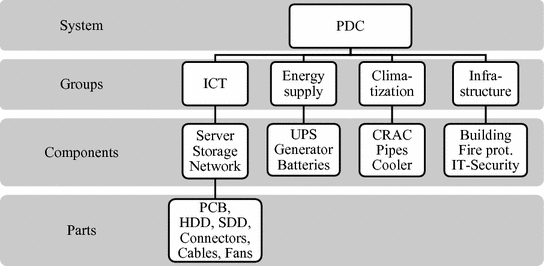
The first portion of the analysis focuses on analyzing ICT devices, due to their short operating lifetime and their energy and material intensity. A server for PDC applications is disassembled to analyze its parts composition and material content. With the parts and elements inventory, a model for LCA is constructed to analyze the CED and the CMD. Due to the quality of the data obtained, the uncertainty of the results is assessed using Pedigree Analysis and Monte Carlo simulations.
2.2 Goal and Scope Definition
The objective of the LCA of the server unit is to analyze the CED and CMD during its lifecycle. Different stages are considered: parts production, assembly, and operation. The scope is limited to the end of the operation time, since no recycling strategies or End-of-Life procedures are specified. For the operation of the unit, energy inputs for the cooling and for the service are considered.
The functional unit is the life-time of the device, which is set to 5 years. To calculate the indicators, data on unit composition, parts and weight is required, as well as technical data on power consumption and operating lifetime. A model is then build in openLCA 1.6, which allows also assessing the uncertainties via Pedigree Analysis and Monte Carlo simulations. Data is then analyzed using MATLAB R 2017a.
2.3 Inventory Analysis
Bill of materials of the server
Denomination | Weight (%) | Principal materials |
|---|---|---|
Housing | 50.0 | Steel, Al |
Storage | 21.8 | Steel |
Power supply | 13.2 | Ceramic, steel, Cu, plastics |
PCB | 10.3 | Plastic, Cu, Al, ceramics |
Fans | 4.3 | Steel, plastic, Cu |
Cable | 0.4 | Cu, plastic |
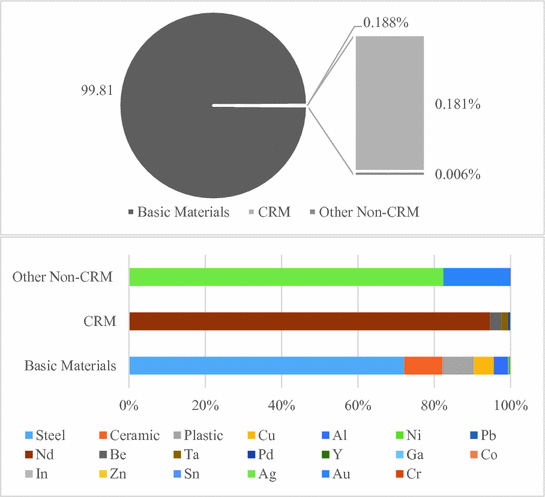

Process diagram for LCA of a server
The characteristic operation of a PDC is one of continuous operation mode with fluctuations on the power consumed by the ICT devices, and with cooling dependent on the outdoor conditions (which may allow the use of free cooling). ICT devices operate in a state between idle mode and maximum power consumption depending on the load. The average load for a device can be estimated as 70% of their maximum load (Rasmussen 2013). The number of operation hours during the year in a PDC are relative high, with an unavailability lower than 12 h/a (BITKOM 2013). This allows estimating the yearly energy consumption of the device, and use it as input for the energy consumption.
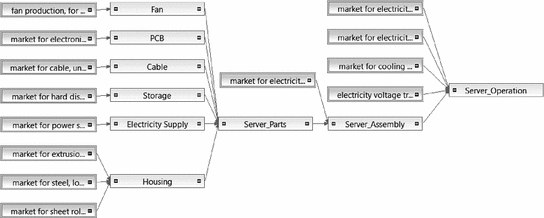
LCA model of the server
Correspondence to the ecoinveint 3.3 database
Denomination | Modeled as | Pedigree matrix | σg |
|---|---|---|---|
Housing | Extrusion of plastic sheets and thermoforming | 1;3;3;3;4 | 1.45 |
Sheet rolling, aluminum | 1;3;2;3;4 | 1.45 | |
Steel, low-alloyed | 1;3;2;3;4 | 1.45 | |
Storage | Hard disk drive, for laptop computer | 1;4;4;3;4 | 1.46 |
Power Supply | Power supply unit, for desktop computer | 1;3;3;4;5 | 1.68 |
PCB | Electronic component, active | 1;3;4;3;5 | 1.69 |
Fans | Fan, for power supply unit, desktop computer | 1;3;2;3;4 | 1.45 |
Cable | Cable, unspecified | 1;3;2;3;2 | 1.10 |
Assembly energy | Electricity, high voltage | 4;3;3;3;3 | 1.15 |
Operation energy | Electricity, medium voltage | 4;3;1;4;3 | 1.44 |
Cooling energy | Cooling energy | 4;3;1;4;4 | 1.58 |
3 Results and Discussion
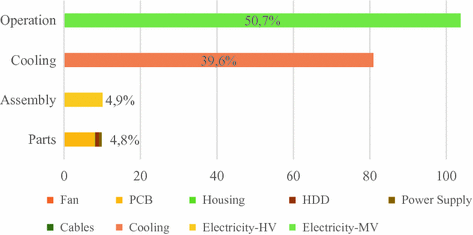
CED fort the analyzed server, MWh
The energy involved in the fabrication and assembly of other components occupy a lower fraction of the CED, 9.7%. This relationship between energy for operation and for fabrication is dependent on the service lifetime of the device, and reducing it increases the significance of the CED outside the operation phase.
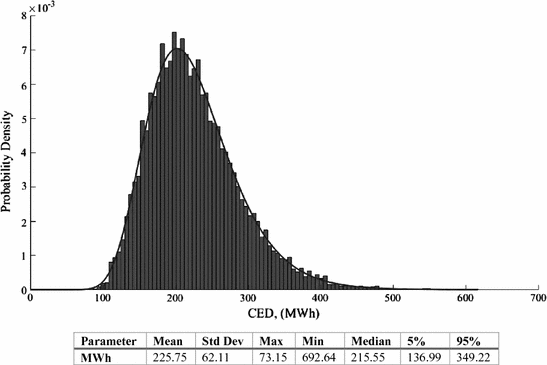
Monte Carlo analysis for the CED of the server. n = 10 000
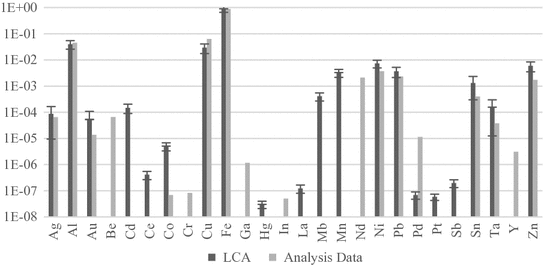
CMD of the server obtained from LCA and from composition analysis. Values in fraction of the total.
Source Analysis data from Szczepaniak and Hobohm (2017)
4 Conclusions and Further Work
The values of CED resulting from the LCA show the importance of the operation phase in the total energy consumption, this in link with the lifetime of the device. A major part of the CED outside the operation phase is the fabrication of PCB (printed circuit boards), with is also of relevance in the End-of-Life stages due to its material content.
The logarithmic normal distribution of the CED presents a standard deviation of 27.51% of the mean value. This is the result of using databases that require updating and improved matching. A more recent database is required to provide higher certainty in the results. In this case study, different technologies had to be matched with the provided data, so that the model is built to represent the device. Constant sources of uncertainties were the dissimilarity of the technologies, the representativeness of the datasets used, and the temporal correlation of the data sources.
The results on the material content analyzed can be further used to evaluate material efficiencies in the processes of manufacturing the devices, since the difference in the materials present in the device and the material quantities resulting from the CMD analysis indicate material losses during the lifetime. This in conjunction with an analysis for reuse and recycling of the materials present at the End-of-Life of the devices can increase the material and energy efficiency.
Only individual components were analyzed. Future work will continue the analysis of key single components of a PDC and develop indicators for their aggregation for a complete evaluation of such facilities. The extrapolation of results for complete PDC can be evaluated as soon as sufficient indicators are available. Scenarios for the End-of-Life of the various devices that contain CRM will be analyzed when more data regarding the End-of-Life stages is available, so that estimations of energy savings and material gains are calculated to develop appropriate recycling strategies. The optimum replacement of older devices with considerations of the CED is to be investigated as the replacement is usually made because of the expiration of the warranty on the maintenance of the equipment.